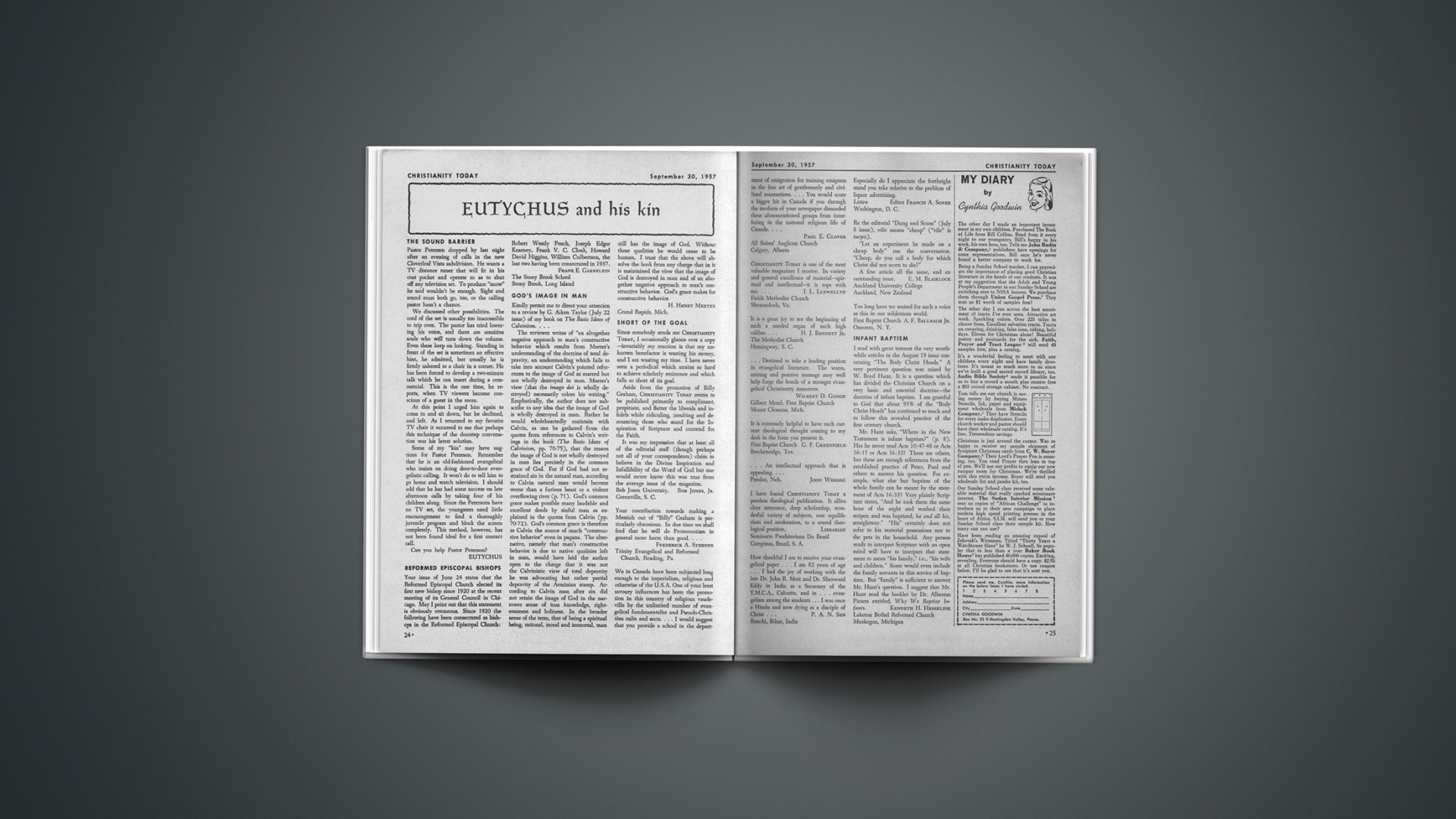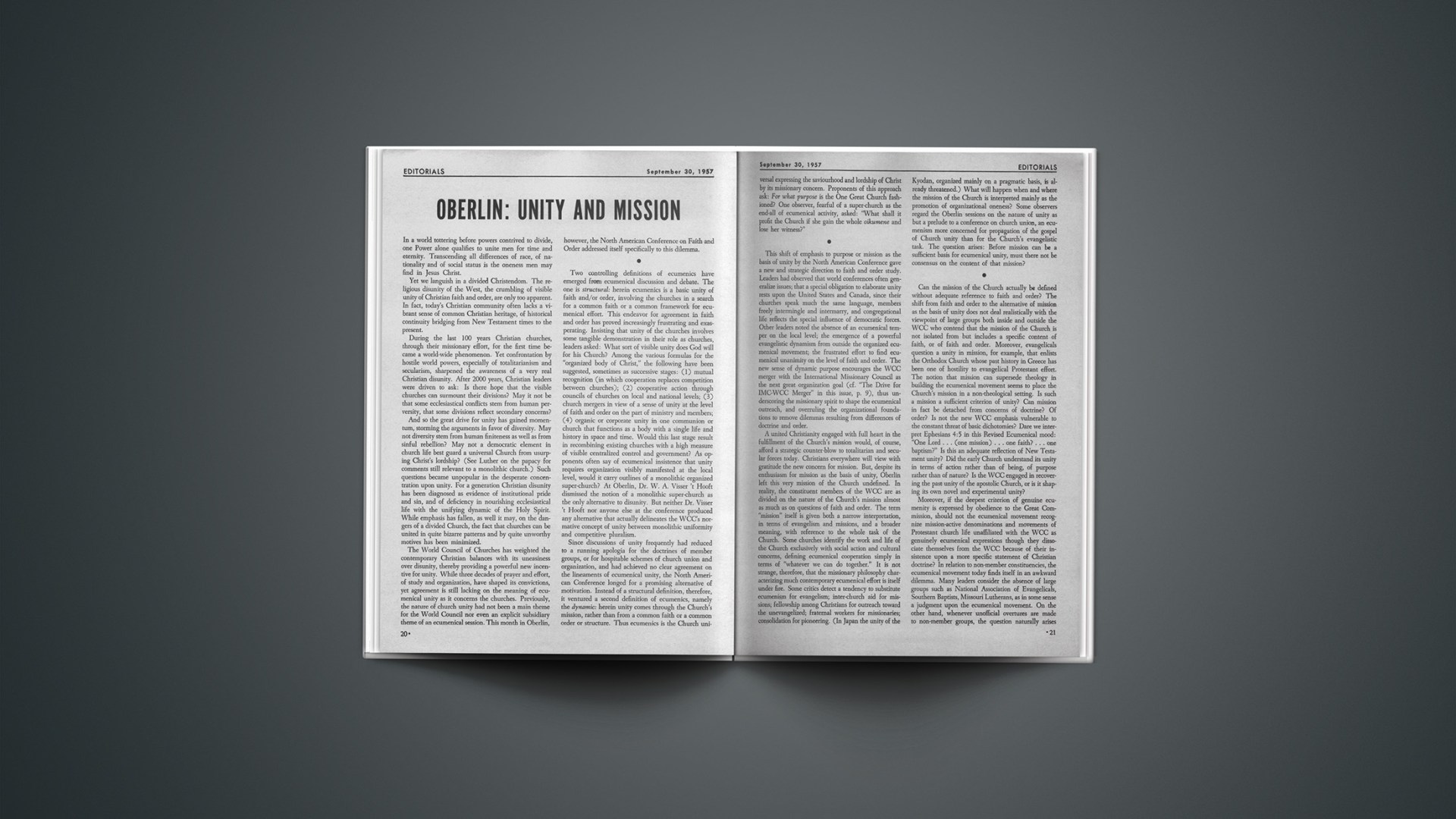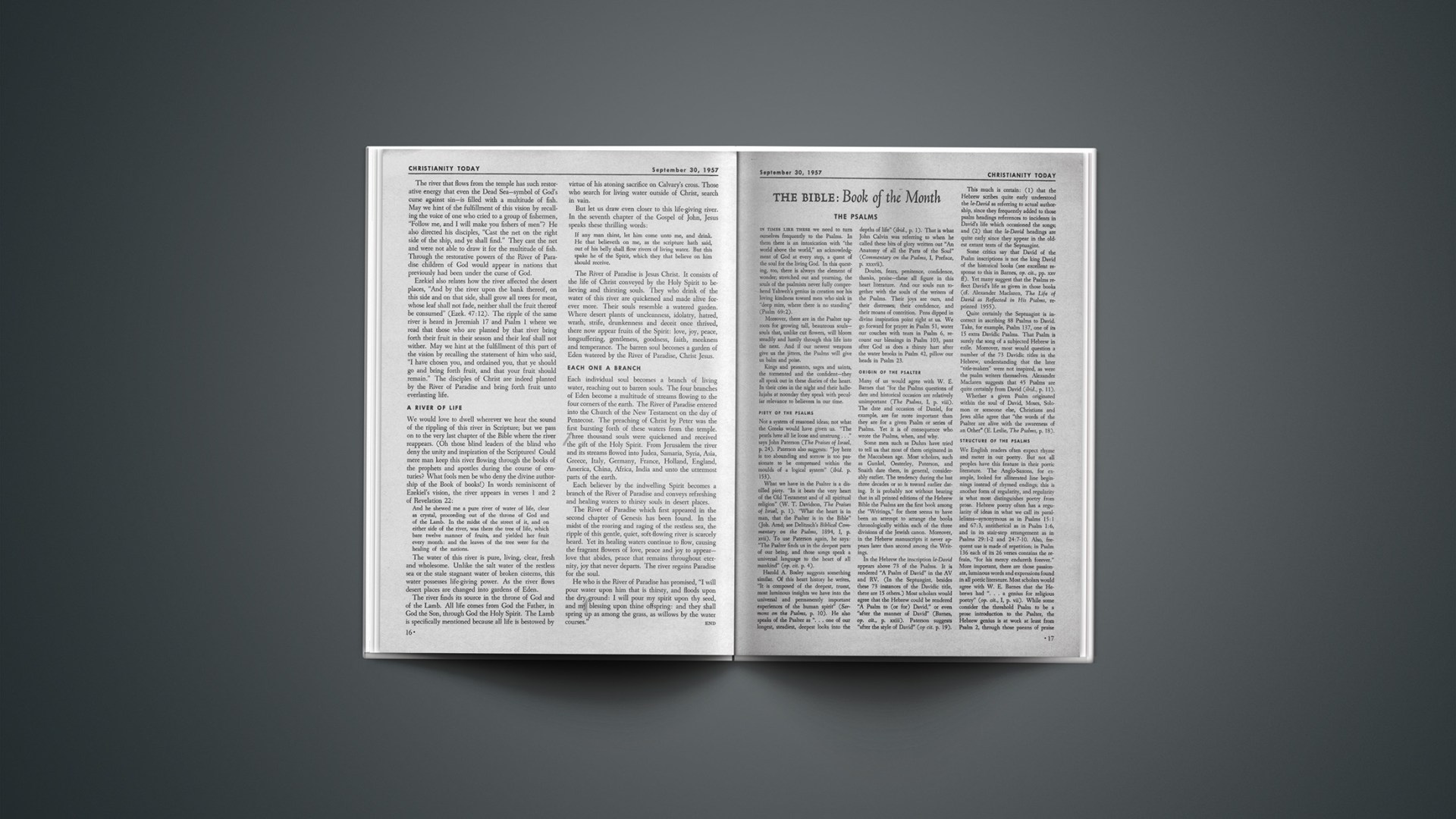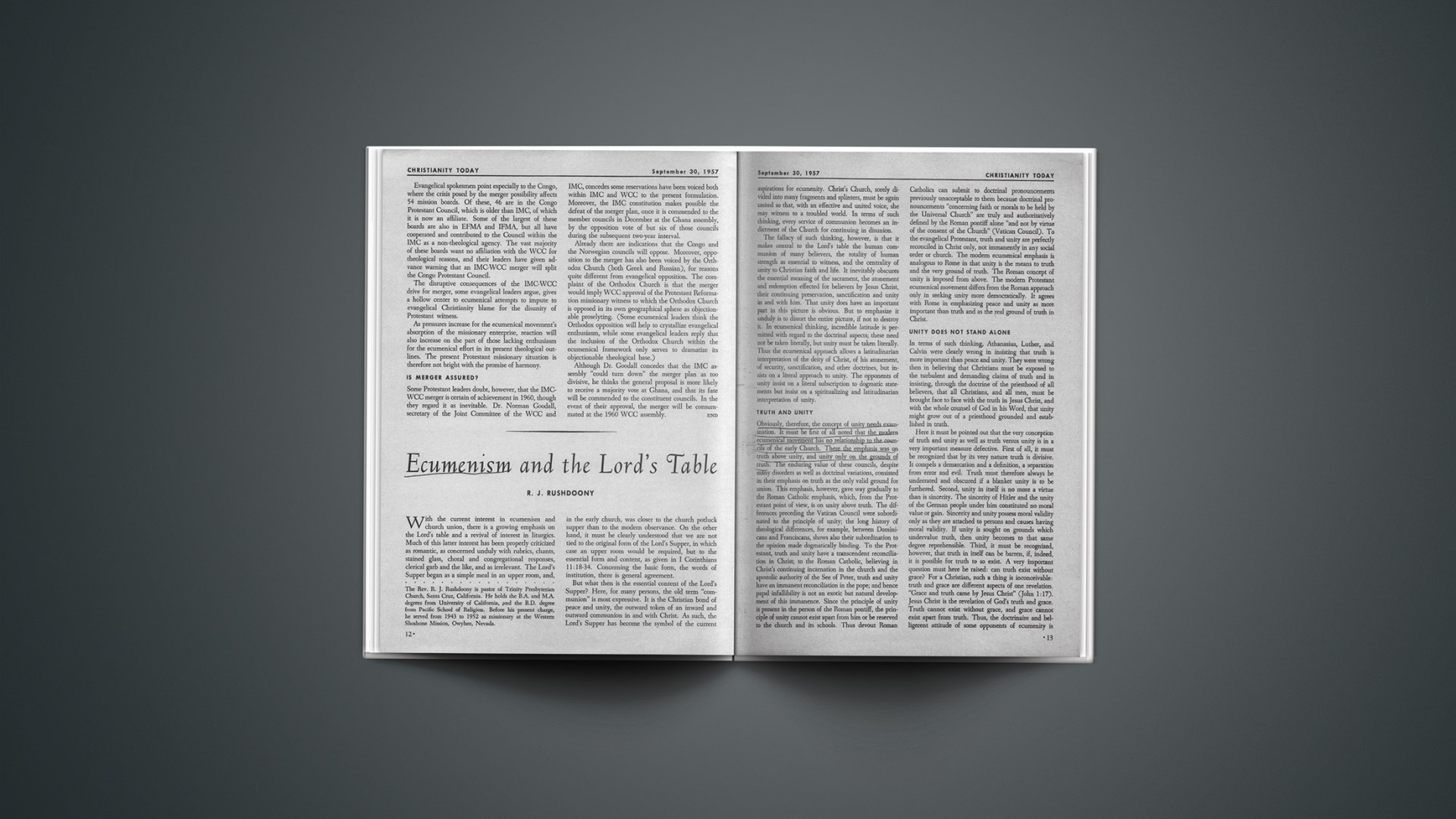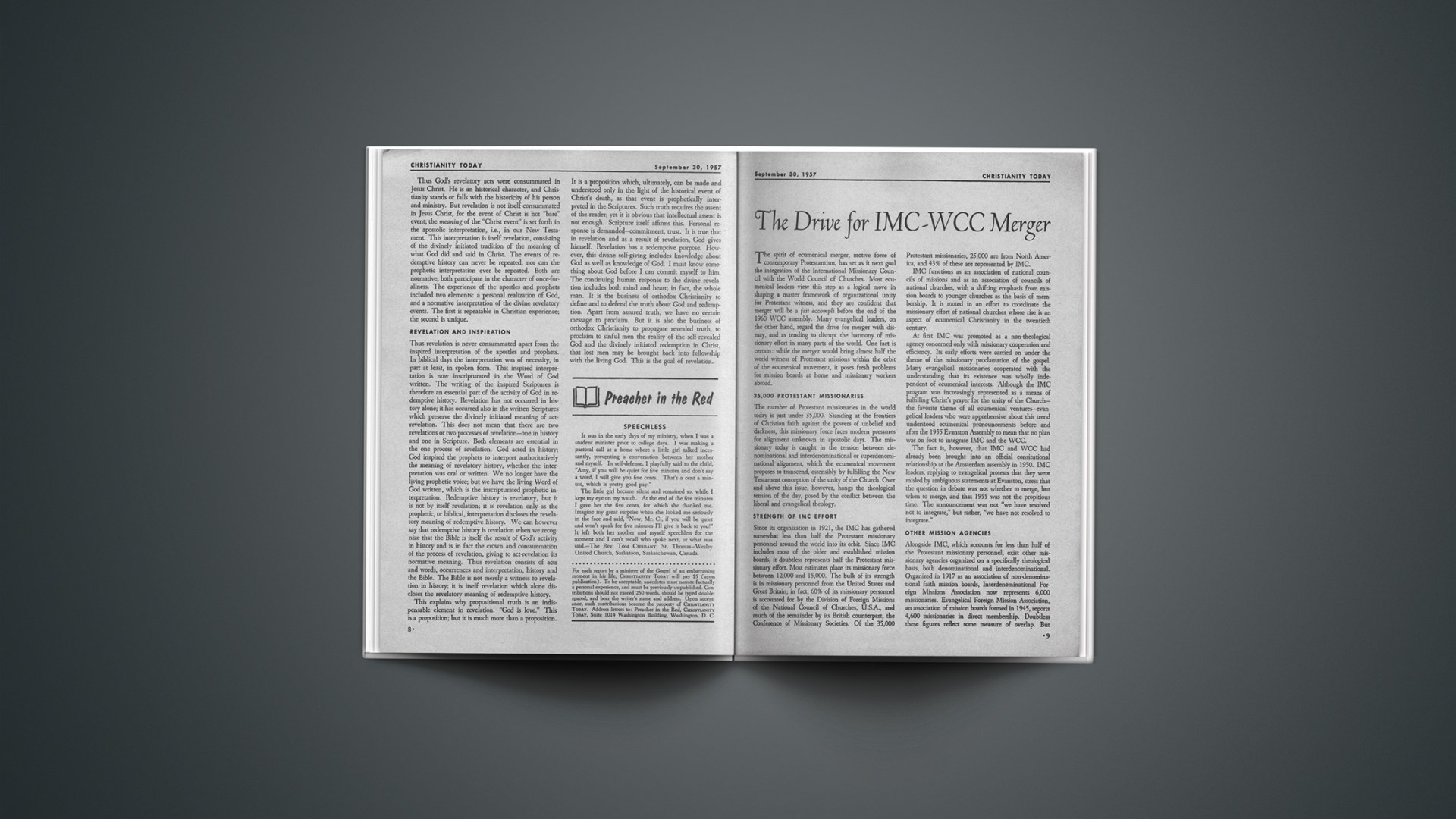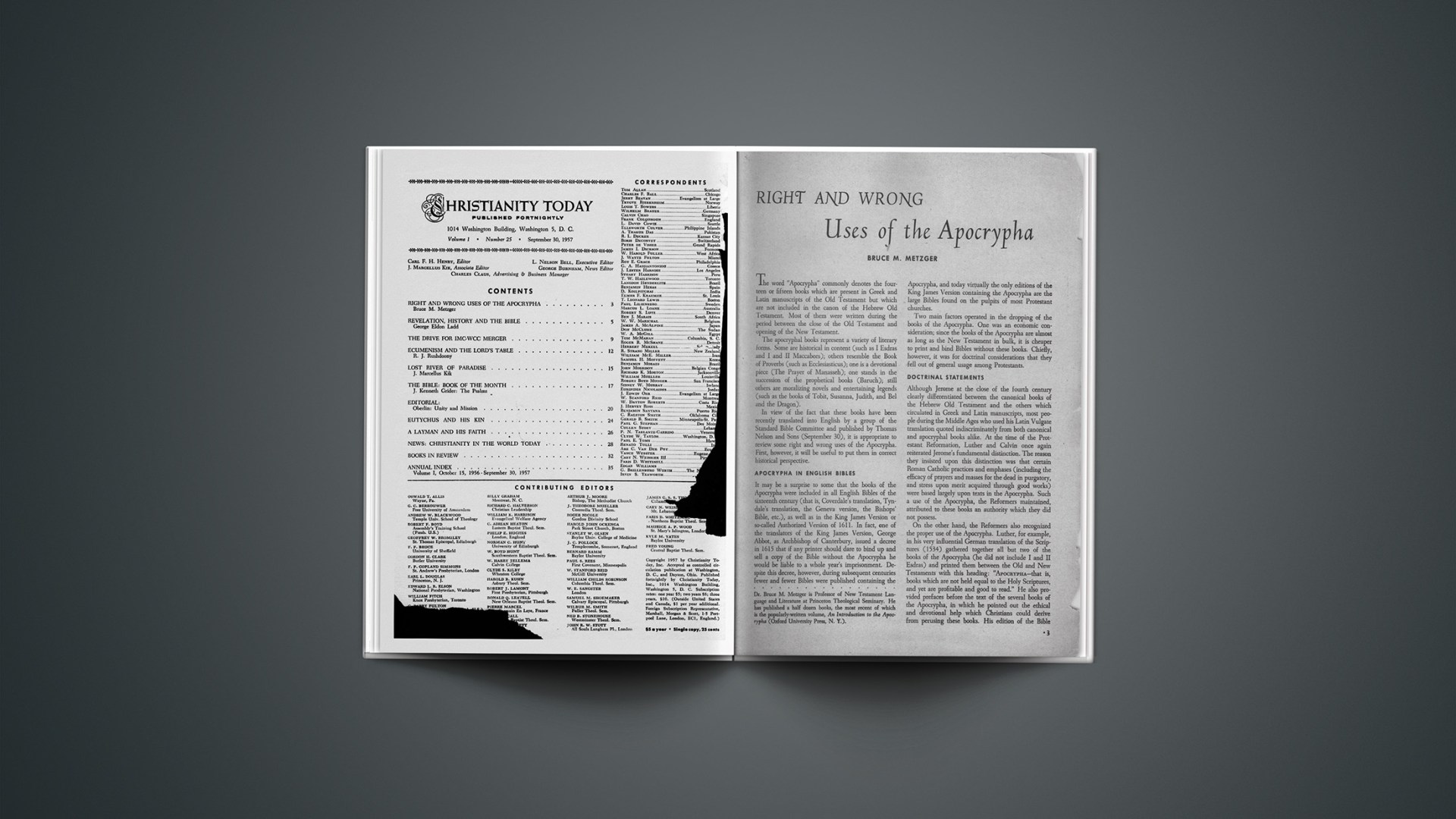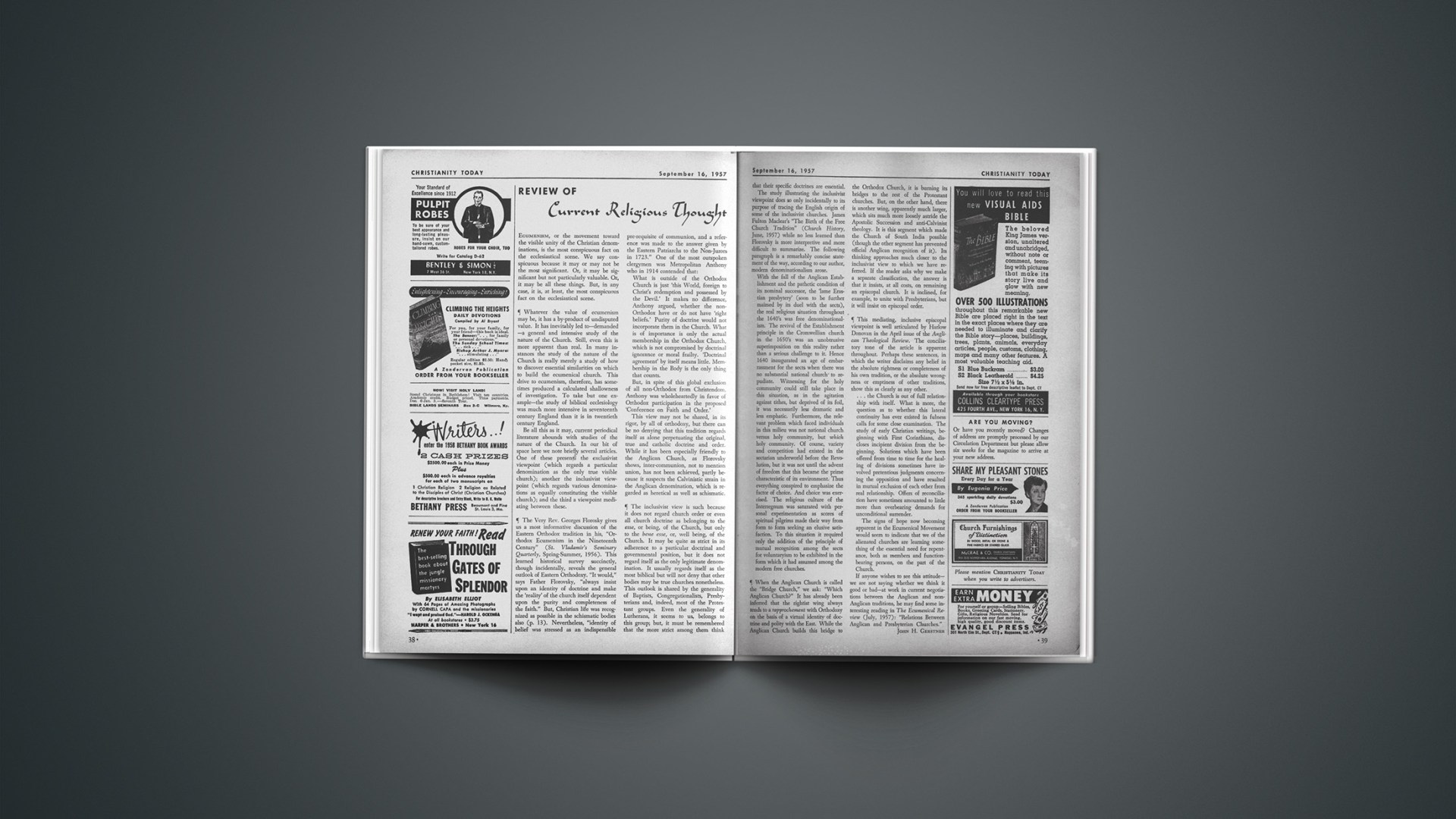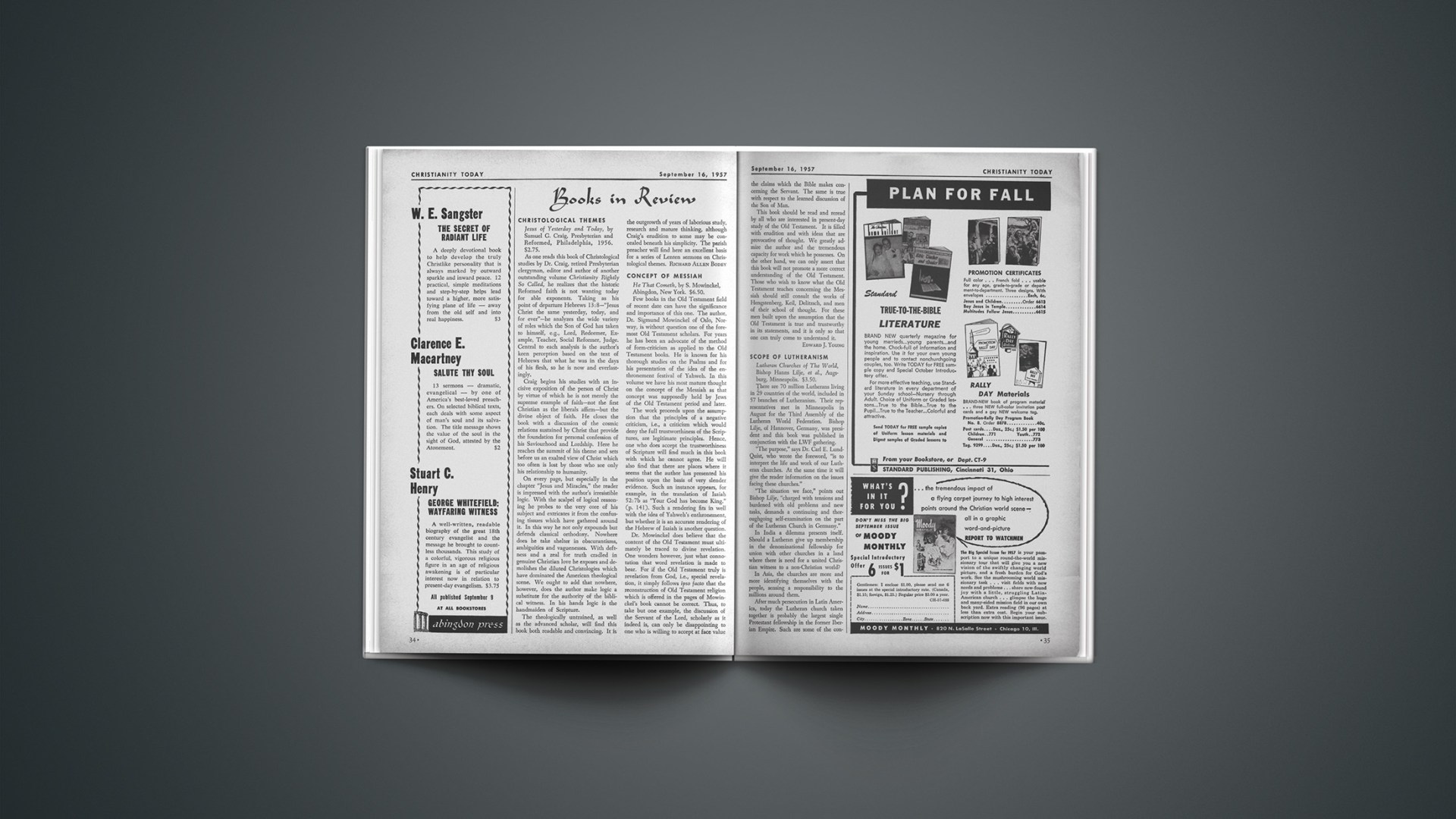THE SOUND BARRIER
Pastor Peterson dropped by last night after an evening of calls in the new Cloverleaf Vista subdivision. He wants a TV distance tuner that will fit in his coat pocket and operate so as to shut off any television set. To produce “snow” he said wouldn’t be enough. Sight and sound must both go, too, or the calling pastor hasn’t a chance.
We discussed other possibilities. The cord of the set is usually too inaccessible to trip over. The pastor has tried lowering his voice, and there are sensitive souls who will turn down the volume. Even these keep on looking. Standing in front of the set is sometimes an effective hint, he admitted, but usually he is firmly ushered to a chair in a corner. He has been forced to develop a two-minute talk which he can insert during a commercial. This is the one time, he reports, when TV viewers become conscious of a guest in the room.
At this point I urged him again to come in and sit down, but he declined, and left. As I returned to my favorite TV chair it occurred to me that perhaps this technique of the doorstep conversation was his latest solution.
Some of my “kin” may have sugtions for Pastor Peterson. Remember that he is an old-fashioned evangelical who insists on doing door-to-door evangelistic calling. It won’t do to tell him to go home and watch television. I should add that he has had some success on late afternoon calls by taking four of his children along. Since the Petersons have no TV set, the youngsters need little encouragement to find a thoroughly juvenile program and block the screen completely. This method, however, has not been found ideal for a first contact call.
Can you help Pastor Peterson?
EUTYCHUS
REFORMED EPISCOPAL BISHOPS
Your issue of June 24 states that the Reformed Episcopal Church elected its first new bishop since 1920 at the recent meeting of its General Council in Chicago. May I point out that this statement is obviously erroneous. Since 1920 the following have been consecrated as bishops in the Reformed Episcopal Church:
Robert Westly Peach, Joseph Edgar Kearney, Frank V. C. Cloak, Howard David Higgins, William Culbertson, the last two having been consecrated in 1937.
FRANK E. GAEBELEIN
The Stony Brook School
Stony Brook, Long Island
GOD’s IMAGE IN MAN
Kindly permit me to direct your attention to a review by G. Aiken Taylor (July 22 issue) of my book on The Basic Ideas of Calvinism.…
The reviewer writes of “an altogether negative approach to man’s constructive behavior which results from Meeter’s understanding of the doctrine of total depravity, an understanding which fails to take into account Calvin’s pointed references to the image of God as marred but not wholly destroyed in man. Meeter’s view (that the imago dei is wholly destroyed) necessarily colors his writing.” Emphatically, the author does not subscribe to any idea that the image of God is wholly destroyed in man. Rather he would wholeheartedly maintain with Calvin, as can be gathered from the quotes from references to Calvin’s writings in the book (The Basic Ideas of Calvinism, pp. 70–75), that the reason the image of God is not wholly destroyed in man lies precisely in the common grace of God. For if God had not restrained sin in the natural man, according to Calvin natural man would become worse than a furious beast or a violent overflowing river (p. 71). God’s common grace makes possible many laudable and excellent deeds by sinful man as explained in the quotes from Calvin (pp. 70–72). God’s common grace is therefore to Calvin the source of much “constructive behavior” even in pagans. The alternative, namely that man’s constructive behavior is due to native qualities left in man, would have laid the author open to the charge that it was not the Calvinistic view of total depravity he was advocating but rather partial depravity of the Arminian stamp. According to Calvin man after sin did not retain the image of God in the narrower sense of true knowledge, righteousness and holiness. In the broader sense of the term, that of being a spiritual being, rational, moral and immortal, man still has the image of God. Without these qualities he would cease to be human. I trust that the above will absolve the book from any charge that in it is maintained the view that the image of God is destroyed in man and of an altogether negative approach to man’s constructive behavior. God’s grace makes for constructive behavior.
H. HENRY MEETER
Grand Rapids, Mich.
SHORT OF THE GOAL
Since somebody sends me CHRISTIANITY TODAY, I occasionally glance over a copy—invariably my reaction is that my unknown benefactor is wasting his money, and I am wasting my time. I have never seen a periodical which strains so hard to achieve scholarly eminence and which falls so short of its goal.
Aside from the promotion of Billy Graham, CHRISTIANITY TODAY seems to be published primarily to compliment, propitiate, and flatter the liberals and infidels while ridiculing, insulting and denouncing those who stand for the Inspiration of Scripture and contend for the Faith.
It was my impression that at least all of the editorial staff (though perhaps not all of your correspondents) claim to believe in the Divine Inspiration and Infallibility of the Word of God but one would never know this was true from the average issue of the magazine.
BOB JONES, JR.
Bob Jones University,
Greenville, S. C.
Your contribution towards making a Messiah out of “Billy” Graham is particularly obnoxious. In due time we shall find that he will do Protestantism in general more harm than good.…
FREDERICK A. STERNER
Trinity Evangelical and Reformed Church, Reading, Pa.
We in Canada have been subjected long enough to the imperialism, religious and otherwise of the U.S.A. One of your least savoury influences has been the promotion in this country of religious vaudeville by the unlimited number of evangelical fundamentalist and Pseudo-Christian cults and sects.… I would suggest that you provide a school in the department of emigration for training emigrees in the fine art of gentlemanly and civilized mannerisms.… You would score a bigger hit in Canada if you through the medium of your newspaper dissuaded these aforementioned groups from interfering in the national religious life of Canada.…
PAUL E. GLOVER
All Saints’ Anglican Church
Calgary, Alberta
CHRISTIANITY TODAY is one of the most valuable magazines I receive. In variety and general excellence of material—spiritual and intellectual—it is tops with me.…
I. L. LLEWELLYN
Fields Methodist Church
Shenandoah, Va.
It is a great joy to see the beginning of such a needed organ of such high calibre.…
H. J. BENNETT JR.
The Methodist Church
Hemingway, S. C.
… Destined to take a leading position in evangelical literature. The warm, uniting and positive message may well help forge the bonds of a stronger evangelical Christianity tomorrow.
WILBERT D. GOUGH
Gilbert Meml. First Baptist Church
Mount Clemens, Mich.
It is extremely helpful to have such current theological thought coming to my desk in the form you present it.
G. F. GREENFIELD
First Baptist Church
Breckenridge, Tex.
… An intellectual approach that is appealing.…
JOHN WEBORG
Pendor, Neb.
I have found CHRISTIANITY TODAY a peerless theological publication. It allies clear utterance, deep scholarship, wonderful variety of subjects, rare equilibrium and moderation, to a sound theological position.
LIBRARIAN
Seminario Presbiteriana Do Brasil
Campinas, Brazil, S. A.
How thankful I am to receive your evangelical paper … I am 82 years of age … I had the joy of working with the late Dr. John R. Mott and Dr. Sherwood Eddy in India as a Secretary of the Y.M.C.A., Calcutta, and in … evangelism among the students … I was once a Hindu and now dying as a disciple of Christ …
P. A. N. SEN
Ranchi, Bihar, India
Especially do I appreciate the forthright stand you take relative to the problem of liquor advertising.
Editor FRANCIS A. SOPER
Listen
Washington, D. C.
Re the editorial “Dung and Scum” (July 8 issue), vilis means “cheap” (“vile” is turpis).
“Let an experiment be made on a cheap body” ran the conversation. “Cheap, do you call a body for which Christ did not scorn to die?”
A fine article all the same, and an outstanding issue.
E. M. BLAIKLOCK
Auckland University College
Auckland, New Zealand
Too long have we waited for such a voice as this in our wilderness world.
A. F. BALLBACH JR.
First Baptist Church
Oneonta, N. Y.
INFANT BAPTISM
I read with great interest the very worthwhile articles in the August 19 issue concerning “The Body Christ Heads.” A very pertinent question was raised by W. Boyd Hunt. It is a question which has divided the Christian Church on a very basic and essential doctrine—the doctrine of infant baptism. I am grateful to God that about 95% of the “Body Christ Heads” has continued to teach and to follow this revealed practice of the first century church.
Mr. Hunt asks, “Where in the New Testament is infant baptism?” (p. 8). Has he never read Acts 10:47–48 or Acts 16:15 or Acts 16:33? There are others, but these are enough references from the established practice of Peter, Paul and others to answer his question. For example, what else but baptism of the whole family can be meant by the statement of Acts 16:33? Very plainly Scripture states, “And he took them the same hour of the night and washed their stripes; and was baptized, he and all his, straightway.” “His” certainly does not refer to his material possessions nor to the pets in the household. Any person ready to interpret Scripture with an open mind will have to interpret that statement to mean “his family,” i.e., “his wife and children.” Some would even include the family servants in this service of baptism. But “family” is sufficient to answer Mr. Hunt’s question. I suggest that Mr. Hunt read the booklet by Dr. Albertus Pieters entitled, Why We Baptize Infants.
KENNETH H. HESSELINK
Laketon Bethel Reformed Church
Muskegon, Michigan

